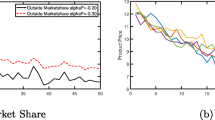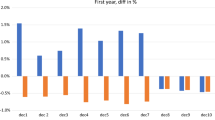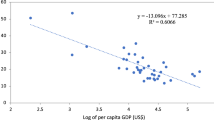Abstract
Economic impact analysis simulation models frequently rely on some kind of representation of consumption behavior. However, the sensitivity of such results with respect to the choices of the specification and the level of aggregation across consumers has not yet been thoroughly examined. We exploit a unique dataset to simulate various stereotypical scenarios and investigate the influence of the choice between six demand system specifications and household-level versus national-level models on several outcome measures. We find that both choices have a large influence on simulation results and thus on policies deduced therefrom. Our results point to pragmatic recommendations for various settings.






Similar content being viewed by others
Notes
More precisely, we define the number of independent parameters as the number of parameters minus the number of independent equations of the demand model specification. In the context of systems of equations, this is usually termed degrees of freedom, see, for example, Sydsæter et al. (2012, p. 449f.).
Lewbel defined the rank “...to be the maximum dimension of the function space spanned by the Engel curves of the demand system.” (Lewbel 1991, p. 711).
He also found that the required rank decreases to two if the observations at the tails of the income distribution are excluded.
For an extensive discussion of the term calibration, see Dawkins et al. (2001).
More formally, a demand system is effectively globally regular if there exists a linearly homogeneous price index P(p) nondecreasing in prices p, and the system satisfies the regularity properties for all real incomes \(\frac{M}{P(p)}\) greater than some minimum level \(\kappa \) (Cooper and McLaren 1996).
Wolff et al. (2010) have introduced an approach that ensures regularity over a freely defined region during the econometric estimation of a demand system. However, nothing guarantees that this property will survive the calibration of a demand function to the parameters estimated.
See “Appendix A” for a formal description.
The CES also needs some sort of calibration while the CD does not. In the literature, the CES mainly finds use as a demand specification in highly aggregated models, such as macroeconomic models.
The Allen elasticity of substitution is defined as \(\varepsilon ^c_{ij} / w_j\) with \(\varepsilon ^c_{ij}\) denoting the compensated cross-price elasticity.
Hanoch (1975) derives the IAS from the CDE by adding the restriction \(\tau _i \beta _i = g\) with \(g=-1\), which cancels out the utility term, and by substituting \(\psi _i \beta _i\) with \(\alpha _i\).
The bottom, middle, and top lines of each box represent the first, second (median), and third quartiles, respectively, and the whiskers extend to 1.5 times the interquartile range. For the sake of an improved scale of the graph, outliers are not shown.
For further details on the generalized cross-entropy estimation model, see “Appendix B”.
The GCE value of the AIDS is indeed further penalized compared to the other specifications as it also includes the deviations in the cross-price elasticities.
More specifically, we constructed a matrix according to Eq. (14) from Deaton and Muellbauer (1980b).
Here, eigenvalues are counted as being positive if they are greater than \(10^{-6}\).
Mathematically, income bias is defined as \(100 \cdot \frac{\sum _{h \in H} \Omega _h M_h (-1 + \sum _{i \in I} |w_{hi}|)}{\sum _{h \in H} \Omega _h M_h}\).
For each scenario and item i, a random number \(z_i\) is drawn from a uniform distribution. Then, the new price \(p_i'\) is calculated as \(p_i'=p_i \cdot \left( \frac{z_i \cdot \left( \frac{1}{0.8}-1\right) \cdot \sum _{j \in I}p_j q_j}{\sum _{j \in I} z_i p_i q_i } + 1\right) \).
Note that the cross-price elasticity variables could be reduced to the upper or lower triangle of the matrix without loss of information if the estimates are known to satisfy the symmetry property.
References
Anderson K, Martin W, van der Mensbrugghe D (2006) Would multilateral trade reform benefit Sub-Saharan Africans? J Afr Econ 15(4):626–670
Banks J, Blundell R, Lewbel A (1996) Tax reform and welfare measurement: Do we need demand system estimation? Econ J 106(438):1227–41
Banks J, Blundell R, Lewbel A (1997) Quadratic Engel curves and consumer demand. Rev Econ Stat 79(4):527–539
Barnett WA, Serletis A (2008) Consumer preferences and demand systems. J Econom 147(2):210–224
Blundell R, Stoker TM (2007) Models of aggregate economic relationships that account for heterogeneity. In: Heckman J, Leamer E (eds) Handbook of econometrics, vol 6. Elsevier, Amsterdam, pp 4609–4666
Bourguignon F, da Silva LAP, Bussolo M (eds) (2008) The impact of macroeconomic policies on poverty and income distribution: macro-micro evaluation techniques and tools. The World Bank and Palgrave MacMillan, Washington
Boysen O (2016) Food demand characteristics in Uganda: estimation and policy relevance. S Afr J Econ 84(2):260–293
Boysen O, Miller AC, Matthews A (2016) Economic and household impacts of projected policy changes for the Irish agri-food sector. J Agr Econ 67(1):105–129
Caves DW, Christensen LR (1980) Global properties of flexible functional forms. Am Econ Rev 70(3):422–32
Cooper RJ, McLaren KR (1996) A system of demand equations satisfying effectively global regularity conditions. Rev Econ Stat 78(2):359–64
Cooper RJ, McLaren KR, Rehman F, Szewczyk WA (2015) Economic welfare evaluation in an era of rapid technological change. Econ Lett 131:38–40
Cranfield JAL, Eales JS, Hertel TW, Preckel PV (2003) Model selection when estimating and predicting consumer demands using international, cross section data. Empir Econ 28(2):353–364
Dawkins C, Srinivasan T, Whalley J (2001) Calibration. In: Heckman JJ, Leamer E (eds) Handbook of econometrics, vol 5. Elsevier, Amsterdam, pp 3653–3703
de Boer P (2010) Modeling household behavior in a CGE model: linear expenditure system or indirect addilog? In: DEGIT Conference Paper c015XXSlahUndXX059, dynamics, economic growth, and international trade, DEGIT - XV Conference, 3 to 4 September 2010. Frankfurt, Germany
de Boer P, Paap R (2009) Testing non-nested demand relations: linear expenditure system versus indirect addilog. Statistica Neerlandica 63(3):368–384
de Janvry A, Sadoulet E (2010) The global food crisis and Guatemala: What crisis and for whom? World Dev 38(9):1328–1339
Deaton A, Muellbauer J (1980a) Economics and consumer behavior. Cambridge University Press, Cambridge
Deaton AS, Muellbauer J (1980b) An almost ideal demand system. Am Econ Rev 70(3):312–26
Decoster A, Schokkaert E (1990) Tax reform results with different demand systems. J Public Econ 41(3):277–296
Fisher D, Fleissig AR, Serletis A (2001) An empirical comparison of flexible demand system functional forms. J Appl Econom 16(1):59–80
Foster J, Greer J, Thorbecke E (1984) A class of decomposable poverty measures. Econometrica 52(3):761–66
Gohin A (2005) The specification of price and income elasticities in computable general equilibrium models: an application of latent separability. Econ Model 22(5):905–925
Golan A, Judge G, Miller D (1996) Maximum entropy econometrics. Wiley, New York
Gorman WM (1981) Some Engel curves. In: Deaton A (ed) Essays in the theory and measurement of consumer behaviour in honor of Sir Richard Stone. Cambridge University Press, Cambridge, pp 7–29
Hanoch G (1975) Production and demand models with direct or indirect implicit additivity. Econometrica 43(3):395–419
Hertel TW (ed) (1997) Global trade analysis: modeling and applications. Cambridge University Press, Cambridge
Hertel T (2013) Global applied general equilibrium analysis using the global trade analysis project framework. In: Dixon PB, Jorgenson DW (eds) Handbook of computable general equilibrium modeling, vol 1. Elsevier, Amsterdam, pp 815–876
Hertel T, van der Mensbrugghe D (2016) Behavioral parameters. In: B. Narayanan, A. Aguiar and R. McDougall (eds), GTAP 9 Data Base Documentation, Center for Global Trade Analysis, Department of Agricultural Economics, Purdue University, West Lafayette
Houthakker HS (1960) Additive preferences. Econometrica 28(2):244–257
Jensen B, de Boer P, van Daal J, Jensen P (2011) Global restrictions on the parameters of the CDES indirect utility function. J Econ 102(3):217–235
King MA (1983) Welfare analysis of tax reforms using household data. J Public Econ 21(2):183–214
Klevmarken N (1979) A comparative study of complete systems of demand functions. J Econom 10(2):165–191
Lewbel A (1991) The rank of demand systems: theory and nonparametric estimation. Econometrica 59(3):711–730
Madden D (1996) Marginal tax reform and the specification of consumer demand systems. Oxf Econ Pap 48(4):556–567
Mas-Colell A, Whinston M, Green J (1995) Microeconomic Theory. Oxford University Press, New York
McLaren KR, Yang O (2016) A class of demand systems satisfying global regularity and having complete rank flexibility. Empir Econ 51(1):315–337
Parks RW (1969) Systems of demand equations: an empirical comparison of alternative functional forms. Econometrica 37(4):629–650
Perroni C, Rutherford TF (1998) A comparison of the performance of flexible functional forms for use in applied general equilibrium modelling. Comput Econ 11(3):245–63
Pollak RA (1971) Additive utility functions and linear Engel curves. Rev Econ Stud 38(4):401–414
Pollak RA, Wales TJ (1995) Demand system specification and estimation. Oxford University Press, New York
Ray R (1986) Sensitivity of ‘optimal’ commodity tax rates to alternative demand functional forms. J Public Econ 31(2):253–268
Ray R (1999) Marginal and non-marginal commodity tax reforms with rank two and rank three demographic demand systems. Oxf Econ Pap 51(4):689–712
Ryan DL, Wales TJ (1998) A simple method for imposing local curvature in some flexible consumer-demand systems. J Bus Econ Stat 16(3):331–38
Simler KR (2010) The short-term impact of higher food prices on poverty in Uganda, Policy Research Working Paper 5210, The World Bank, Washington
Stone R (1954) Linear expenditure systems and demand analysis: an application to the pattern of British demand. Econ J 64(255):511–527
Sydsæter K, Hammond P, Strøm A (2012) Essential mathematics for economic analysis, 4th edn. Pearson Education Limited, Harlow
UBOS (2014) Uganda National Household Survey 2012/2013. Uganda Bureau of Statistics, Kampala, Uganda
Wodon Q, Zaman H (2010) Higher food prices in Sub-Saharan Africa: poverty impact and policy responses. World Bank Res Obs 25(1):157–176
Wolff H, Heckelei T, Mittelhammer R (2010) Imposing curvature and monotonicity on flexible functional forms: an efficient regional approach. Comput Econ 36(4):309–339
Yu W, Hertel TW, Preckel PV, Eales JS (2004) Projecting world food demand using alternative demand systems. Econ Model 21(1):99–129
Acknowledgements
I would like to thank three anonymous referees for their constructive comments which greatly helped to improve this article. I am indebted to Sherman Robinson for many insightful discussions.
Author information
Authors and Affiliations
Corresponding author
Appendices
Appendices
A: The quadratic almost ideal demand system (QUAIDS)
The QUAIDS was introduced by Banks et al. (1997) and is an extension of the AIDS due to Muellbauer(1980b, see Sect. 3.5). It is defined by the budget share Eq. (37), the price indices a(p) (38) and b(p) (39), and restrictions to impose adding up (40), homogeneity (41), and symmetry (42). The income and price elasticities are defined by Eqs. (43) and (44)
with Kronecker \(\delta _{ij}\) (see Sect. 3.3). The QUAIDS has \((n^2 + 3n)/2 - 1\) independent parameters and is thus flexible. In comparison with the rank two AIDS that restricts budget shares to be linear in the log of income, the QUAIDS is of rank three and adds flexibility to the Engel curves representable by adding a term quadratic in the log of income. As a consequence, the QUAIDS allows income elasticities to vary with the level of income such that an item might be a luxury for low and a necessity for high income levels. The QUAIDS specification does not guarantee compliance with the monotonicity or curvature properties and thus might not be regular even for the price-income points of the sample observations. McLaren and Yang (2016) state that its regularity properties are not better than those of the AIDS. The QUAIDS does not impose any bounds on the value ranges of the income and price elasticities.
B: Generalized cross-entropy estimation model
The goal of this estimation is to generate a theoretically consistent set of parameters for a specific demand system which precisely replicates the given budget shares \(w_i=\frac{p_i q_i}{M}\) (\(q_i\) denotes the quantity demanded) at a given income (M) and a vector of prices \(p_i\) while fitting a given set of prior income \(\overline{\eta }_i\) and price elasticities \(\overline{\varepsilon }_{ij}\) as closely as possible, where \(i,j \in I\) and I denotes the set of consumption items.
Equations (45) to (50) form the core model of the GCE estimation, which then needs to be amended with the specific constraints of the particular demand system model:
subject to
The cross-entropy objective function (45) minimizes the distance—as measured by the Kullback-Leibler measure (see, e.g., Golan et al. 1996) of information divergence—of the estimated probability distribution \(\pi _{i(j)l}^s\) from their prior probabilities \(\overline{\pi }^s_{i(j)l}\), where \(s \in S=\{\eta , \varepsilon \}\) indicates parameters associated with the income and price elasticities, respectively. The prior probabilities are chosen such that their implied expected value is equal to the prior elasticity. The importance of each item’s elasticity with respect to the entire demand system is assumed to be proportional to the corresponding budget share \(w_i\) which enters the objective function as a weight. Since the number of cross-price elasticities is quadratically related to the number of items, these are weighted by the product of the budget shares of the two items involved \(w_i w_j\).Footnote 21 Equations (46) and (47) link the income and price elasticity variables \(\eta _i\) and \(\varepsilon _{ij}\) to their expected values, defined as the sum over the support points \(z_{i(j)l}^s\) (indexed by \(l \in L\)) multiplied by their respective probabilities \(\pi _{i(j)l}^s\). Equations (48) and (49) ensure that probabilities sum to one. In addition, restrictions (50) confine probability variables to the nonnegative domain.
The vector of support points associated with a specific elasticity defines the support range in which the estimated elasticity is allowed to fall. Since the estimated elasticity, for example, \(\eta _i\), is calculated as the sum of all support points multiplied by their associated probabilities (Eq. 46), the prior elasticity is chosen as the midpoint of the support point vector \(z_{il}\) and the support points extend equidistantly from each other and symmetrically around the midpoint. For example, if the prior income elasticity is \(\eta _i=1.2\), a support space of \(|L|=5\) points is chosen and it is assumed that the error around the elasticity is uniformly distributed (the prior distribution) \(\pi _i^\eta = \overline{\pi }_i^\eta = (0.2,0.2,0.2,0.2,0.2)\), then \(z_i^\eta = (0.2,0.7,1.2,1.7,2.2)\) so that Eq. (46) initially evaluates to the prior income elasticity \(\overline{\eta }_{i}\). Alternatively, the error might be assumed to be normally distributed around the prior elasticity, which can be accomplished by assigning different probabilities to \(\overline{\pi }_i^\eta \) which approximate a normal distribution function. This attributes a higher probability to a support point the closer it is to the midpoint of the support range and thus assumes there is information about the distribution of the error around the prior elasticity.
To complete the GCE demand system estimation model, the core GCE model needs to be complemented by equations which define the demand system (budget share equations and parameter domain definitions) and its income and price elasticities.
Rights and permissions
About this article
Cite this article
Boysen, O. When does specification or aggregation across consumers matter for economic impact analysis models? An investigation into demand systems. Empir Econ 56, 137–172 (2019). https://doi.org/10.1007/s00181-017-1353-z
Received:
Accepted:
Published:
Issue Date:
DOI: https://doi.org/10.1007/s00181-017-1353-z




